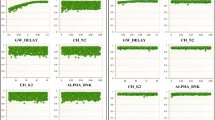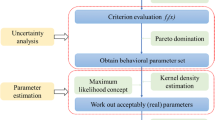Abstract
Calibration is one of the most important steps of hydrological modeling and applications. Observed data availability and model parameterization are two important factors affecting the calibration efficiency of the models. This study focuses on the assessment of the effects of the number and location of sites (LoS), number of parameters (NoP), and the calibration method (CM) on the performance of the SWAT hydrological model of a basin. Accordingly, twelve different models with respect to LoS, NoP, and CM are built for the Sirwan River Basin in Iran. NS, R-factor and P-factor efficiency criteria are then used to evaluate how well the models perform both in calibration and validation stages. In order to prioritize the models, TOPSIS multi-criteria decision analysis approach is applied to aggregate different efficiency criteria and to discriminate between the models. Results show the usefulness of the proposed MCDA-based approach to rank different alternatives (settings) of model calibration. Additionally, multi-site calibration is not always better than single-site calibration, and the locations of the sites included in the calibration procedure are also important in this respect.


Similar content being viewed by others
References
Abbaspour K, Johnson C, Van Genuchten MT (2004) Estimating uncertain flow and transport parameters using a sequential uncertainty fitting procedure. Vadose Zone J 3:1340–1352
Abbaspour K, Rouholahnejad E, Vaghefi S, Srinivasan R, Yang H, Kløve B (2015) A continental-scale hydrology and water quality model for Europe: calibration and uncertainty of a high-resolution large-scale SWAT model. J Hydrol 524:733–752
Abbaspour KC (2015) SWAT-CUP: SWAT calibration and uncertainty programs–a user manual. Swiss Federal Institute of Aquatic Science and Technology, Eawag
Abbaspour KC, Yang J, Maximov I et al (2007) Modelling hydrology and water quality in the pre-alpine/alpine Thur watershed using SWAT. J Hydrol 333:413–430
Ahmadi M, Arabi M, Ascough JC, Fontane DG, Engel BA (2014) Toward improved calibration of watershed models: multisite multiobjective measures of information. Environ Model Softw 59:135–145
Arnold JG, Moriasi DN, Gassman PW et al (2012) SWAT: model use, calibration, and validation. Trans ASABE 55:1491–1508
Arnold JG, Youssef MA, Yen H et al (2015) Hydrological processes and model representation: impact of soft data on calibration. Trans ASABE 58:1637–1660
Asl Rousta B, Araghinejad S (2015) Development of a multi criteria decision making tool for a water resources decision support system. Water Resour Manag 29:5713–5727
Asl-Rousta B, Mousavi SJ, Ehtiat M, Ahmadi M (2018) SWAT-based hydrological modelling using model selection criteria. Water Resour Manag 32:2181–2197
Bai J, Shen Z, Yan T (2017) A comparison of single-and multi-site calibration and validation: a case study of SWAT in the Miyun reservoir watershed. Chin Front Earth Sci: 1–9
Bannwarth M, Hugenschmidt C, Sangchan W et al (2015) Simulation of stream flow components in a mountainous catchment in northern Thailand with SWAT, using the ANSELM calibration approach. Hydrol Process 29:1340–1352
Bekele EG, Nicklow JW (2007) Multi-objective automatic calibration of SWAT using NSGA-II. J Hydrol 341:165–176
Cao W, Bowden WB, Davie T, Fenemor A (2006) Multi-variable and multi-site calibration and validation of SWAT in a large mountainous catchment with high spatial variability. Hydrol Process 20:1057–1073
CARD (Center for Agricultural and Rural Development) A, IA (2016) SWAT literature database for peer-reviewed journal articles. https://www.card iastate edu/swat_articles. Accessed 16 Nov 2017
Chiang LC, Yuan Y, Mehaffey M, Jackson M, Chaubey I (2014) Assessing SWAT's performance in the Kaskaskia River watershed as influenced by the number of calibration stations used. Hydrol Process 28:676–687
Chow VT (1959) Open channel hydraulics. McGraw-Hill Book Company Inc, New York
Daggupati P, Yen H, White MJ et al (2015) Impact of model development, calibration and validation decisions on hydrological simulations in West Lake Erie Basin. Hydrol Process 29:5307–5320
FAO G (1995) Digital soil map of the world (GeoLayer), 18 Feb 2014 edn
Faramarzi M, Srinivasan R, Iravani M et al (2015) Setting up a hydrological model of Alberta: data discrimination analyses prior to calibration. Environ Model Softw 74:48–65
Gassman PW, Sadeghi AM, Srinivasan R (2014) Applications of the SWAT model special section: overview and insights. J Environ Qual 43:1–8
Gong Y, Shen Z, Liu R, Hong Q, Wu X (2012) A comparison of single-and multi-gauge based calibrations for hydrological modeling of the upper Daning River watershed in China's three gorges reservoir region. Hydrol Res 43:822–832
Green C, Van Griensven A (2008) Autocalibration in hydrologic modeling: using SWAT2005 in small-scale watersheds. Environ Model Softw 23:422–434
Hajkowicz S, Collins K (2007) A review of multiple criteria analysis for water resource planning and management. Water Resour Manag 21:1553
Hajkowicz S, Higgins A (2008) A comparison of multiple criteria analysis techniques for water resource management. Eur J Oper Res 184:255–265
Hipel KW (1992) Multiple objective decision making in water resources. J Am Water Resour Assoc 28:3–12
Hwang CL, Lai YJ, Liu TY (1993) A new approach for multiple objective decision making. Comput Opera Res 20:889–899
Hwang CL, Yoon KS (1981) Multiple attribute decision-making: methods and applications. Springer, New York
Kim S, Kim Y, Kang N, Kim HS (2015) Application of the entropy method to select calibration sites for hydrological modeling. Water 7:6719–6735
Leta OT, van Griensven A, Bauwens W (2016) Effect of single and multisite calibration techniques on the parameter estimation, performance, and output of a SWAT model of a spatially heterogeneous catchment. J Hydrol Eng 22:05016036
Li Z, Shao Q, Xu Z, Cai X (2010) Analysis of parameter uncertainty in semi-distributed hydrological models using bootstrap method: a case study of SWAT model applied to Yingluoxia watershed in Northwest China. J Hydrol 385:76–83
Malczewski J (1999) GIS and multicriteria decision analysis. John Wiley & Sons Inc, New York
Migliaccio KW, Chaubey I (2007) Comment on Cao W, Bowden BW, Davie T, Fenemor a. 2006.Multi-variable and multi-site calibration and validation of SWAT in a large mountainous catchment with high spatial variability. Hydrological processes 20 (5): 1057-1073. Hydrol Process 21:3226
Moriasi DN, Arnold JG, Van Liew MW, Bingner RL, Harmel RD, Veith TL (2007) Model evaluation guidelines for systematic quantification of accuracy in watershed simulations. Trans ASABE 50:885–900
NASA, JPL (2009) ASTER Global Digital Elevation Model [Data set]
Nash JE, Sutcliffe JV (1970) River flow forecasting through conceptual models part I—A discussion of principles. J Hydrol 10:282–290
Neitsch SL, Arnold JG, Kiniry JR, Williams JR (2011) Soil and water assessment tool theoretical documentation version 2009. Texas Water Resources Institute
Nossent J, Bauwens W (2012) Application of a normalized Nash-Sutcliffe efficiency to improve the accuracy of the Sobol'sensitivity analysis of a hydrological model. In: EGU General Assembly Conference Abstracts: 237
Rouholahnejad E, Abbaspour KC, Srinivasan R, Bacu V, Lehmann A (2014) Water resources of the Black Sea Basin at high spatial and temporal resolution. Water Resour Res 50:5866–5885
Saha S, Moorthi S, Pan HL et al (2010) The NCEP climate forecast system reanalysis. Bull Am Meteorol Soc 91:1015–1057
Shi P et al (2013) Application of a SWAT model for hydrological modeling in the Xixian watershed, China. J Hydrol Eng 18:1522–1529
Srdjevic B, Medeiros YDP, Faria AS (2004) An objective multi-criteria evaluation of water management scenarios. Water Resour Manag 18:35–54
UN-ESCWA, BGR (United Nations Economic and Social Commission for Western Asia; Bundesanstalt für Geowissenschaften und Rohstoffe) (2013) Inventory of shared water resources in Western asia. In: Beirut
USDA-SCS (U.S. Department of Agriculture-Soil Conservation Service) (1986) Urban hydrology for small watersheds. US Soil Conservation Service Technical Release 55:13
White KL, Chaubey I (2005) Sensitivity analysis, calibration, and validations for a multisite and multivariable SWAT model. J Am Water Resour Assoc 41:1077–1089
Williams JR (1969) Flood routing with variable travel time or variable storage coefficients. Trans ASAE 12:100–0103
Zarghami M, Szidarovszky F (2011) Multicriteria analysis: applications to water and environment management. Springer Science & Business Media
Zavadskas EK, Antuchevičienė J, Kapliński O (2015) Multi-criteria decision making in civil engineering. Part II–applications. Eng Struct Technol 7:151–167
Zeleny M (1982) Multiple criteria decision making. McGraw-Hill, New York
Zhang X, Srinivasan R, Liew MV (2010) On the use of multi-algorithm, genetically adaptive multi-objective method for multi-site calibration of the SWAT model. Hydrol Process 24:955–969
Zhang X, Srinivasan R, Van Liew M (2008) Multi-site calibration of the SWAT model for hydrologic modeling. Trans ASABE 51:2039–2049
Author information
Authors and Affiliations
Corresponding author
Ethics declarations
Conflict of Interest
None.
Rights and permissions
About this article
Cite this article
Asl-Rousta, B., Mousavi, S.J. A TOPSIS-Based Multicriteria Approach to the Calibration of a Basin-Scale SWAT Hydrological Model. Water Resour Manage 33, 439–452 (2019). https://doi.org/10.1007/s11269-018-2111-5
Received:
Accepted:
Published:
Issue Date:
DOI: https://doi.org/10.1007/s11269-018-2111-5




